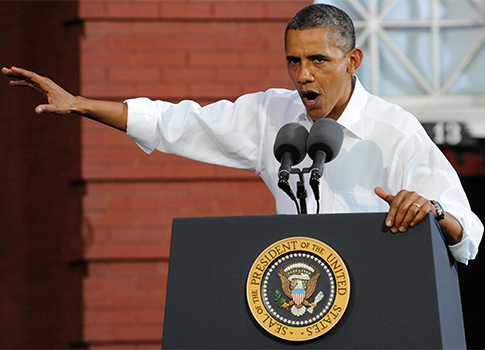President Barack Obama is repeating a debunked claim regarding his commitment to deficit reduction, one of the highest priority issues for voters this election cycle.
In a campaign video unveiled Wednesday, the president called for a "new economic patriotism" and touted his "balanced plan to reduce our deficit by $4 trillion over the next decade."
The claim that Obama has a plan—in the form of his most recent budget proposal—to reduce the federal deficit by $4 trillion over 10 years has been a constant refrain from the president on the campaign trail, and has been echoed by his Democratic allies.
Former President Bill Clinton, for example, praised Obama’s "reasonable plan of $4 trillion in debt reduction over a decade" during his primetime speech at the Democratic National Convention in Charlotte, N.C.
However, as Glenn Kessler, the Washington Post’s in-house fact-checker, has made clear: "The repeated claim that Obama’s budget reduces the deficit by $4 trillion is simply not accurate."
"Virtually no serious budget analyst agreed" with the Obama administration’s accounting with respect to the $4 trillion figure, Kessler found.
Independent experts panned the president’s budget for its "troubling" reliance on gimmicks and accounting tricks to inflate the magnitude of the savings being proposed.
Keith Hennessey, a former director of the National Economic Council, estimated the true value of Obama’s deficit reduction—minus these gimmicks—to be about $2.8 trillion, and called even that reduced figure a "generous" assessment.
The president’s budget, for instance, takes credit for about $1 trillion in spending cuts that were already signed into law in 2011, and should already be incorporated given that they fall outside the 10-year budget window.
The budget also includes another $800 billion in phantom savings related to the military drawdowns in Iraq and Afghanistan—money that would never have been spent to begin with—and another $800 billion in projected savings due to reduced interest payments on the debt, something not traditionally cited in federal budget documents as a form of government "spending" that can be "cut."
"Drawing down spending on wars that were already set to wind down and that were deficit financed in the first place should not be considered savings," Maya MacGuineas, president of the Committee for a Responsible Federal Budget, said in a statement criticizing Obama’s use of accounting gimmicks. "When you finish college, you don’t suddenly have thousands of dollars a year to spend elsewhere—in fact, you have to find a way to pay back your loans."
These imaginary "savings" are then used to finance new federal spending, as Obama acknowledges in the campaign video.
"As we end the war in Afghanistan, let’s apply half the savings to pay down our debt and use the rest for some nation-building right here at home," he says.
"Fake money is being used to pay for real spending projects," Kessler explains.
Furthermore, the idea that savings from the drawdown in Afghanistan—even if those savings were real—could "pay down our debt," as Obama suggests, is simply not credible.
The federal debt, which recently hit $16 trillion, is projected to grow to $25.4 trillion by the year 2022 under Obama’s budget.
Obama’s proposals, activist MacGuineas noted, would "barely stabilize the debt—and at too high a level," much less pay it down.
Even the liberal Ezra Klein has acknowledged that "there’s a good case to be made that Obama’s budget doesn’t actually hit the deficit-reduction target it’s implying that it hits."
Obama and his allies also routinely insist that his plan is "balanced," meaning it includes both spending cuts and tax increases. The Bowles-Simpson deficit commission, which Obama did not endorse, advocated such an approach.
Some Democrats have tried to equate Obama’s plan with that of Bowles-Simpson but, as Kessler points out, the Bowles-Simpson plan "is actually quite different, calling for tough spending cuts and substantial tax reforms—not the faux proposals contained in the president’s budget."
The Office of Management and Budget (OMB)’s own figures reveal that Obama’s budget would net just $14 billion in reduced federal spending over the next decade, compared to its baseline projections, which effectively represents the status quo.
Total federal spending would rise from $3.8 trillion this year to $5.8 trillion in 2022, an increase of 53 percent.
The president’s extreme reluctance to rein in federal spending is captured in Bob Woodward’s latest book, The Price of Politics.
Obama, Woodward writes, wanted to put forward a $4 trillion deficit reduction plan, but felt the spending cuts necessary to achieve that goal "were too severe. The progressive and liberal base would be deeply distressed."
The result was a plan full of gimmicks, and imaginary savings, that is not "balanced" at all. Ultimately, Kessler notes, "most of Obama’s claimed deficit reduction comes from his proposed tax increases."
The new taxes proposed in Obama’s budget total $1.8 trillion, according to the OMB.
National media outlets, meanwhile, continue to report Obama’s $4 trillion claim as established fact. The New York Times published an article Tuesday alleging that the president’s budget "called for $5.3 trillion in deficit reduction over the next decade," even higher than what the president’s says in his most recent campaign ad.
The higher figure is culled from the tables accompanying the budget and refers to projected deficit reduction between 2013 and 2022 that also incorporates the same gimmicks and other savings enacted "since January 2011."
